There are so many plants to choose from when creating a terrarium that it can be challenging to narrow them down. All terrarium plants must love humidity and warmth, but other than that, there is a lot of leeway in choosing types.
Terrarium building is immensely popular right now, and for a good reason. It’s a great activity to do with kids, as once it’s created, it needs very little care or upkeep. Plus, they add such a nice pop of color and life to the indoor environment.
This list covers the best vines, ferns, and foliage plants to make your terrarium really stand out. Which ones to choose, though, rests with you. Get creative, don’t be afraid to experiment, and have fun – terrariums are such a joy to watch grow over time!
Types of Terrariums
Terrariums are either open or closed. The type of terrarium you make will depend on what you want to grow. Tropical terrariums are enclosed ecosystems, usually arranged in glass or plastic containers. This is to keep the heat and humidity within the enclosure to mimic the native habitat as best as possible. This list of terrarium plants is for closed ecosystems.
An open terrarium is necessary for plants that need regular air flow, like to dry out a bit, and aren’t fond of high moisture. Cacti and succulents go in open terrariums.
What Makes A Good Terrarium Plant?
A terrarium emulates a tropical rainforest with lots of warmth and humidity. So, it makes sense that tropical species are the best plants for terrariums. However, not all tropical species automatically are suitable matches for a small, indoor terrarium.
The plants that do best in terrariums:
- Fit in the desired container or doesn’t mind stunted growth or being trimmed
- Flourish in a warm, humid, and usually sealed environment
- Prosper with limited airflow
- Have shared lighting needs with other plants in the terrariums (bright, indirect being the most common)
Most tropical plants will prosper in a closed terrarium, so then it all comes down to aesthetics, style, size, and personal taste. Sure, some may be large or grow too big for the enclosure, but regular pruning usually quickly fixes that issue. Of course, if you want a no-fuss terrarium, you’ll want to choose plants that won’t overgrow the environment. As you can see, so much depends on the person creating the terrarium.
The three main categories of terrarium plants that we will be covering in this article are:
- Vines
- Foliage
- Ferns
Vining Terrarium Plants
Trailing, climbing, and creeping plants make a terrarium pop with life. These plants will grow up the sides, around other plants, and weave the terrarium together to create a unified ecosystem. There are tons of vines to choose from for any size and shape terrarium.
Creeping Fig (Ficus pumila)
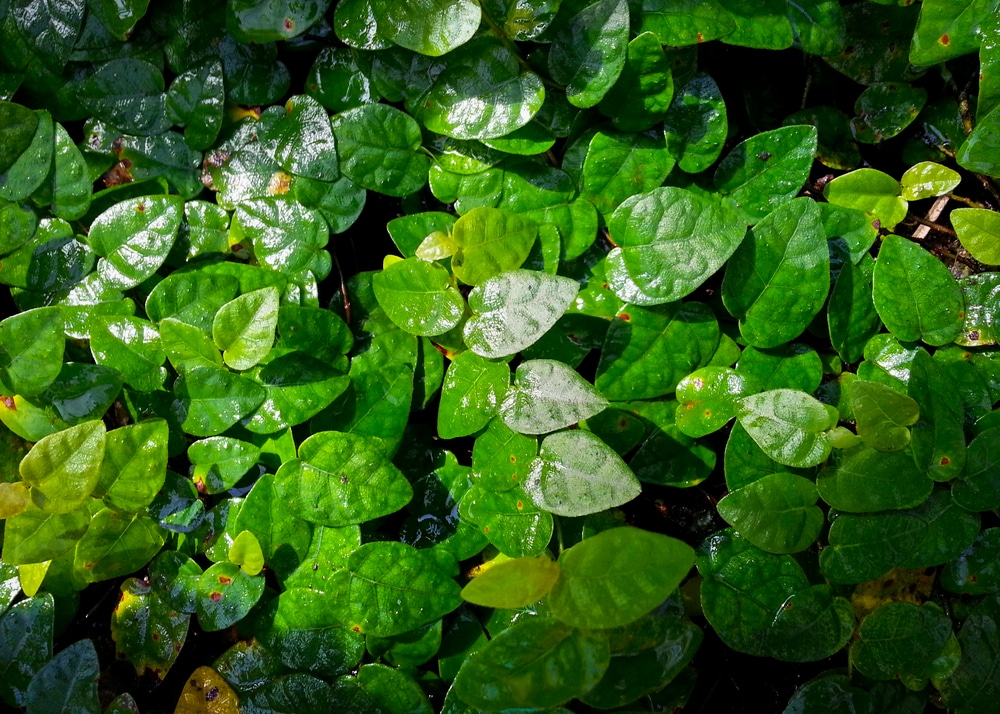
This vining relative of the Rubber tree is vigorous, evergreen, and fast-growing. It features tiny green heart-shaped leaves and climbing stems that are self-clinging. This seemingly innocuous vine will blanket a terrarium wall in no time. You may have to trim it back to ensure it doesn’t crowd out slower-growing plants; that’s the only downside to this fantastic terrarium specimen.
String of Turtles (Peperomia prostrata)
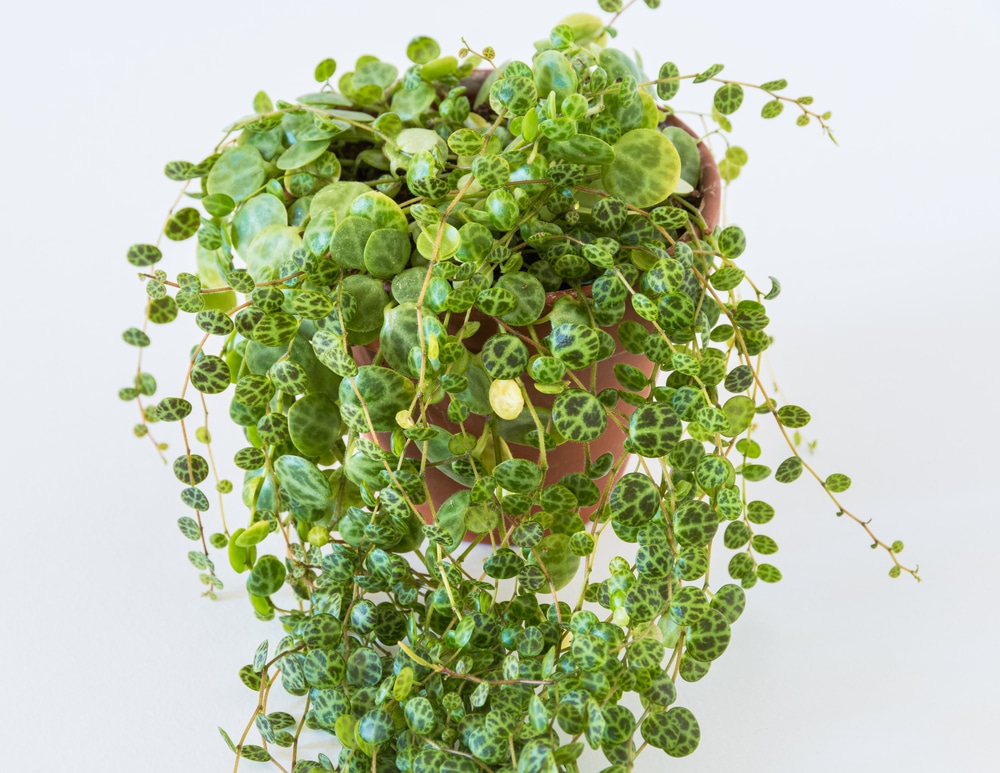
Stunning variegation and thick, fleshy succulent leaves are just two of the draws to this terrarium gem. The foliage coloring looks remarkably like a turtle shell, and its charm is indisputable. String of Turtles grows quickly on a string-like vine and adapts to its environment, but likes high humidity and warmth best.
Shingling Vines (Marcgravia)
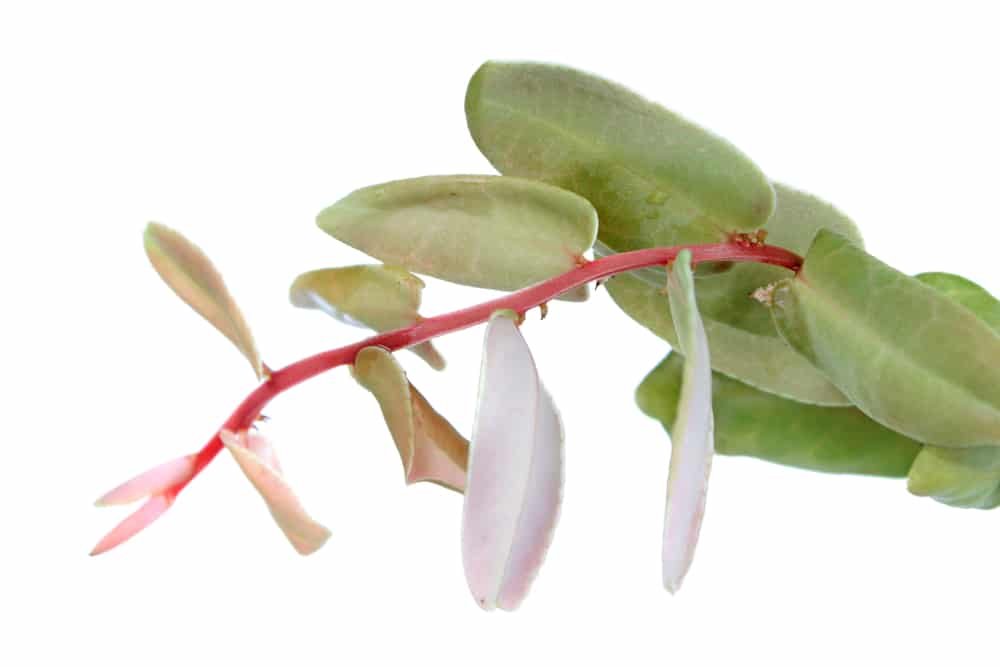
The unique leaves of this vine look like rows of shingles or a rattlesnake’s tail, depending on who you ask. They’re remarkable in the way the tiny leaves form so close together and the way they love to climb. Often, the flat leaves look like they were formed on the surface of whatever they are growing on as they overlap and form a solid wall of color.
There are some genuinely spectacular Marcgravia species, with fascinating foliage coloring from vibrant green to bronze to pastel to variegated. These are just a couple favorites:
- Marcgravia umbellata – This variety sports dusty green leaves with white edges and veining that really stand out.
- Marcgravia Azreal – The dark-green to purplish leaves make the foliage appear iridescent. Its leaves rarely get larger than ½ inch, and it grows quickly.
- Rainbow Marcgravia Sintenisii – The leaves emerge a light red and then morph to green. Each leaf matures at its own pace, giving the overall appearance of a rainbow as they all slowly transform from red to green. A very fun plant!
Dischidia
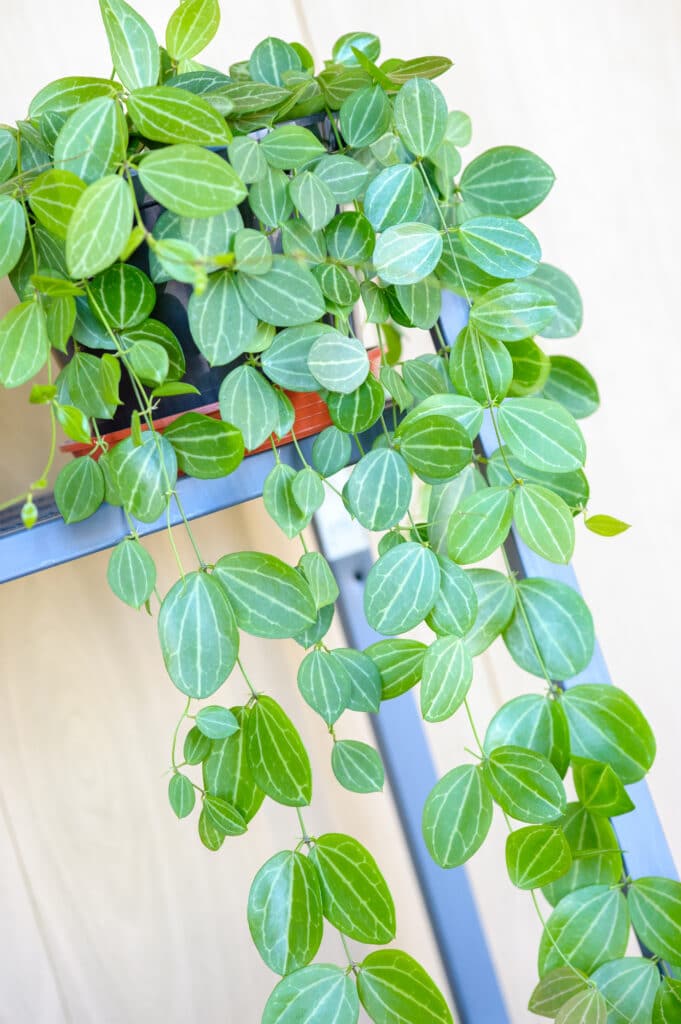
A close relative to the Hoya, the often overlooked Dischidia shouldn’t be overlooked for terrariums. They’re originally from Thailand, and they absolutely love hot and humid conditions.
Dischidia are epiphytes and have a cascading growth habit. They’re best mounted near the top of the terrarium, where they can grow downwards. Some are fast growers while others take their time a bit more, but all of them thrive in a terrarium environment. Of the many Dischidia varieties, there are a few that really stand out:
- Watermelon Dischidia – The deep green leaves with three white stripes look remarkably like a watermelon. The stems are long and trailing, with leaves growing in intervals along them.
- Pebble Beach Dischidia – A dainty climbing or clinging vine with fleshy coin-shaped gray and cream-colored foliage. An unusual specimen.
Peperomia turboensis
This Peperomia plant features dark green and maroon foliage with hints of silver that practically sparkle in the right light. It thrives on high humidity and is perfectly suited for terrarium life. The vines grow compact and low and very quickly. P. turboensis leaves are either almond or heart-shaped, or somewhere in-between – there is a lot of variation in the species.
Watermelon Pellionia (Pellionia pulchra)
Known for their vibrant coloring, Watermelon Pellionia plants light up a terrarium. The foliage is gray-green, satiny in texture, and oblong with distinctive watermelon-like patterning. The fleshy and greenish-pink stems are also attractive and add to the watermelon look.
Watermelon Pellionia is a trailing vine that loves to cascade. It must have high humidity and a warm environment – it’s easier to grow in a terrarium than as a traditional houseplant. This tropical plant is a shingle-type vine, which means it will cling to whatever it is growing on. It will even form itself to the sides of the terrarium for a unique and striking effect.
Foliage
While many of these plants may be vining or climbers, they are on this list due to their highly attractive foliage that will make your terrarium pop with color and intrigue. These plants are the attention-grabbers, show-offs, and grandstanders.
Aluminum Plant (Pilea cadierei)
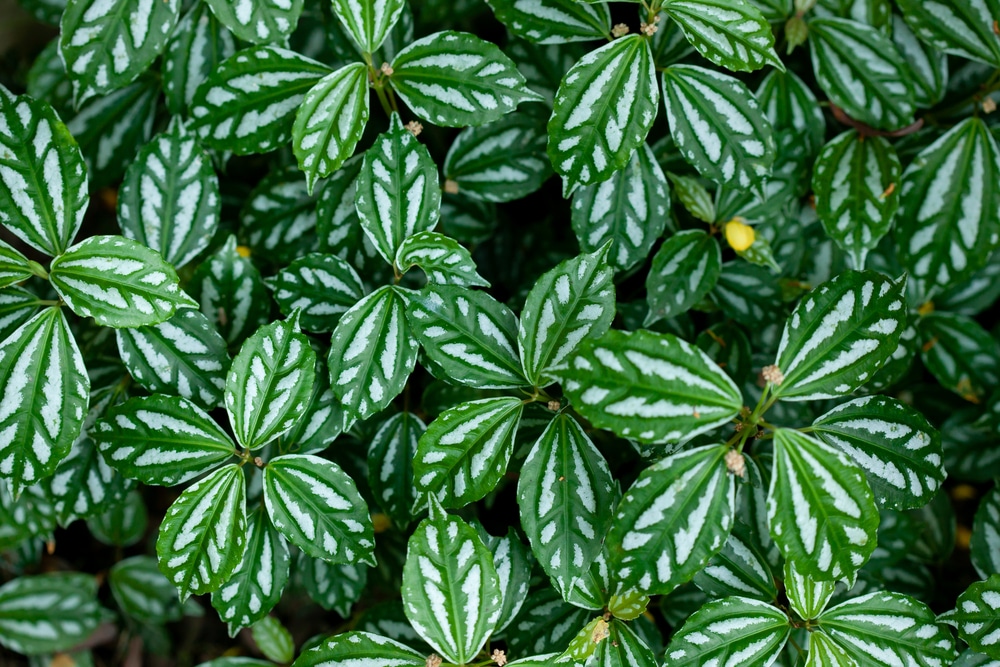
With stunning silver variegated foliage splashed across the leaves, the little low-growing Aluminum plant looks incredible in a terrarium. The Aluminum plant forms compact clusters of leaves and averages 8-12 inches tall. It loves high humidity, warmth, and lots of indirect sunlight.
For tiny terrariums, check out the dwarf Aluminum plant, Pilea cadierei ‘Minima,’ which is only 6” tall at full maturity.
Friendship Plant (Pilea involucrata)
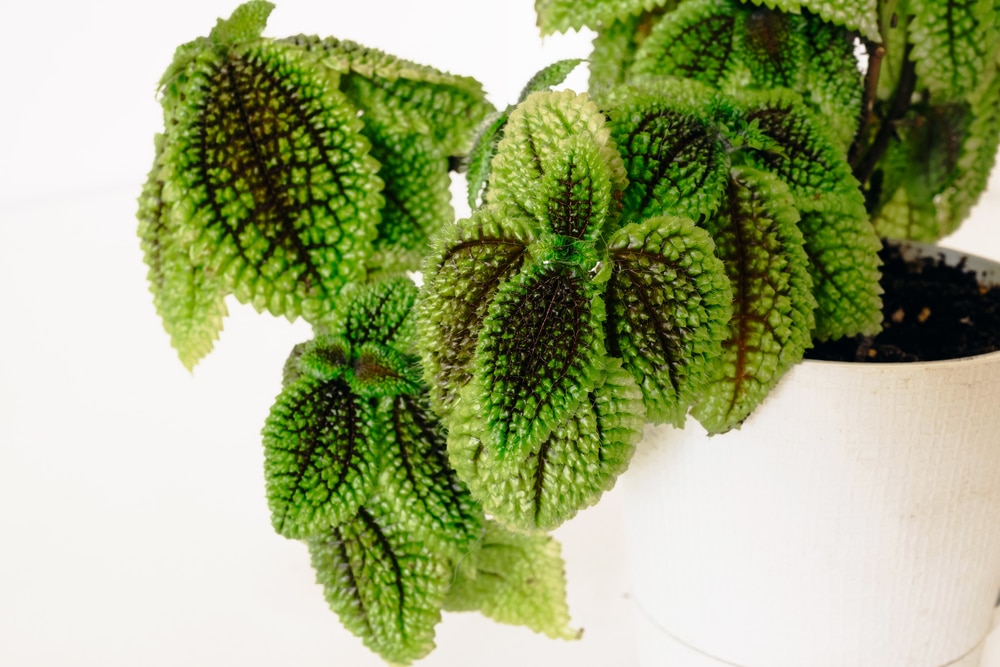
A bushy trailing plant with incredibly textured leaves and contrasting colorful foliage, the Friendship plant really adds character and life to a terrarium. The leaves feature alternating streaks of burgundy and silver or green and silver, and their undersides are purplish. Friendship plants are crawlers and average 8-12 inches long.
Nerve Plants (Fittonia)
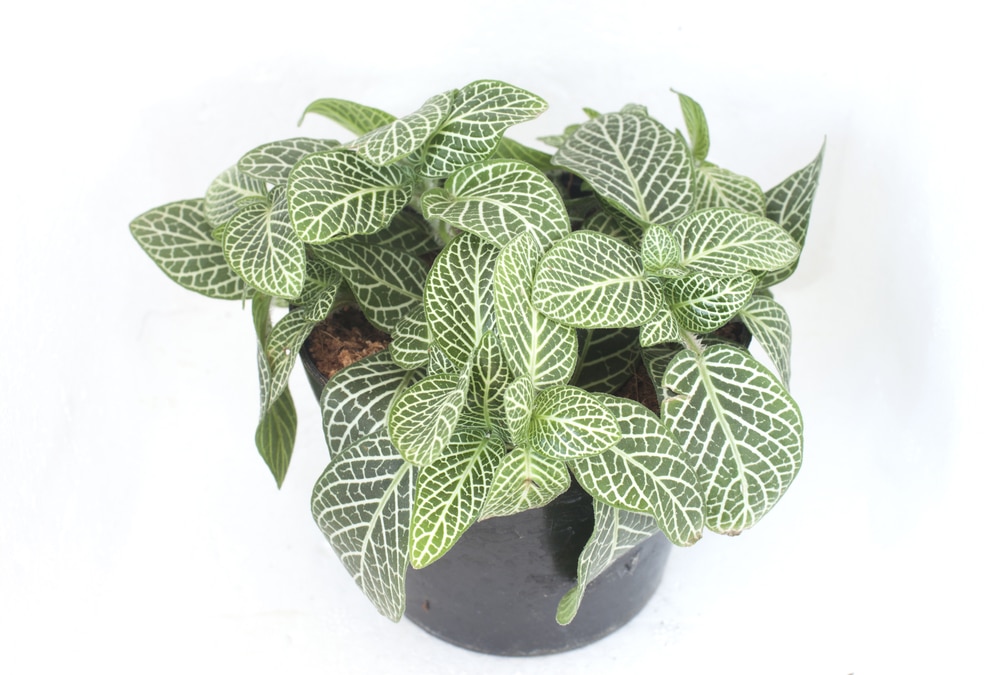
A classic terrarium plant for a good reason, Nerve plants know how to light up a space. The deep green foliage features vividly contrasting veins in either pink, white, light green, or red. Nerve plants usually grow around 6-inches tall but will vine much longer.
Nerve plants love their water and humidity, and if you’ve ever tried to grow one as a classic indoor plant, you know how dramatic they are when they don’t get water exactly when they want it. The terrarium takes all this drama away and lets you enjoy the beauty of this plant care-free.
Strawberry Begonia (Saxifraga stolonifera)
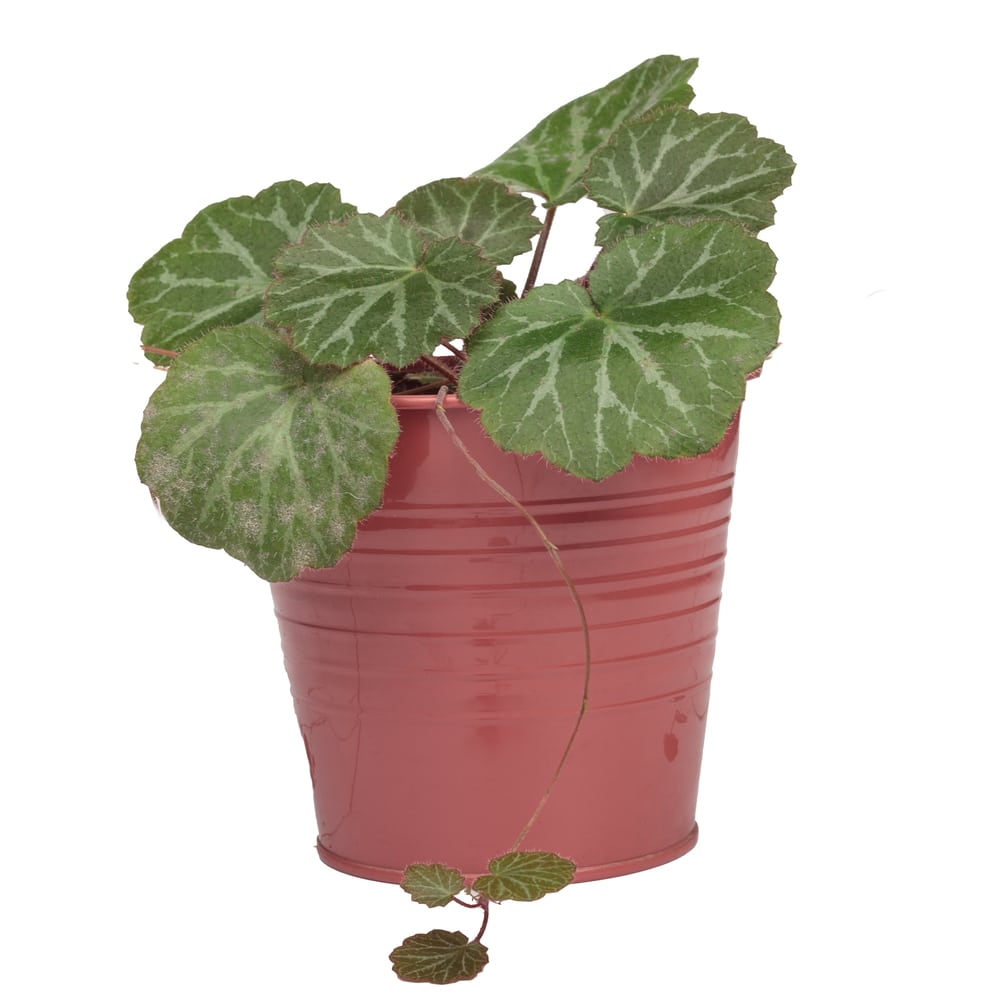
Not a strawberry plant and not a begonia, this beautiful creeping perennial is charming in a terrarium. The foliage is dark-green and rounded with vivid silver markings along the veins and a strawberry-red colored underside. It grows to about 8” tall and will slowly spread out as much as you let it. As it grows, it sends out thin red tendrils to stabilize itself for more growth.
Polka Dot Plants (Hypoestes)
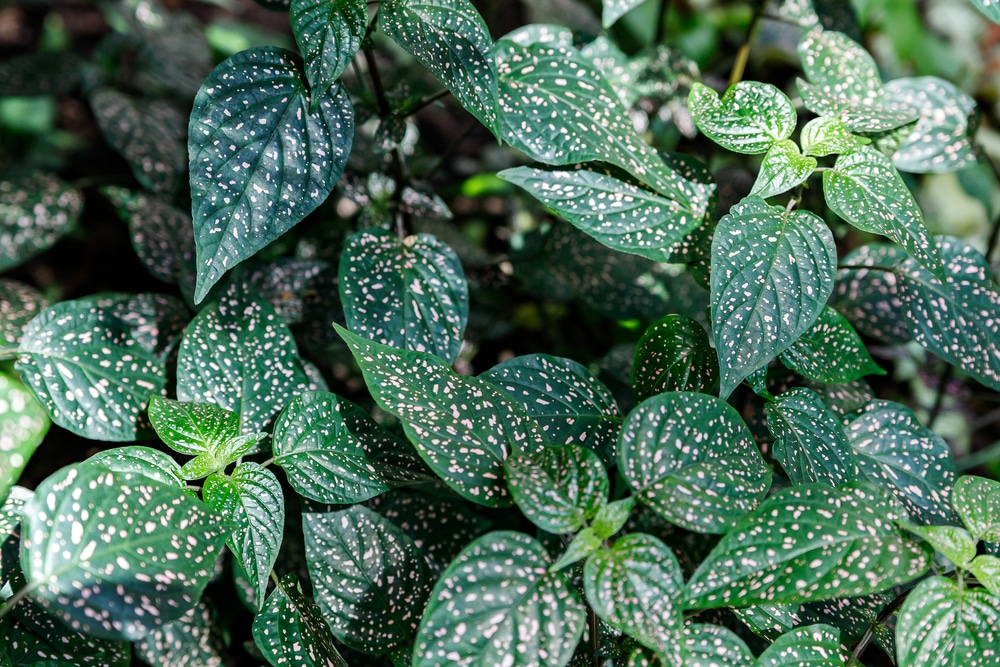
Another regular terrarium choice, Polka Dot plants thrive in high humidity and warmth. Their petite growth habit and stunning pink speckled green leaves create quite an aesthetic impact in the terrarium.
Polka Dot plants aren’t very good climbers and are best placed up high where they can cascade down and display their coloring, like a peacock. The vines may get quite long or busy, so be prepared to trim or cut them as needed.
Earth Stars (Crypanthus)
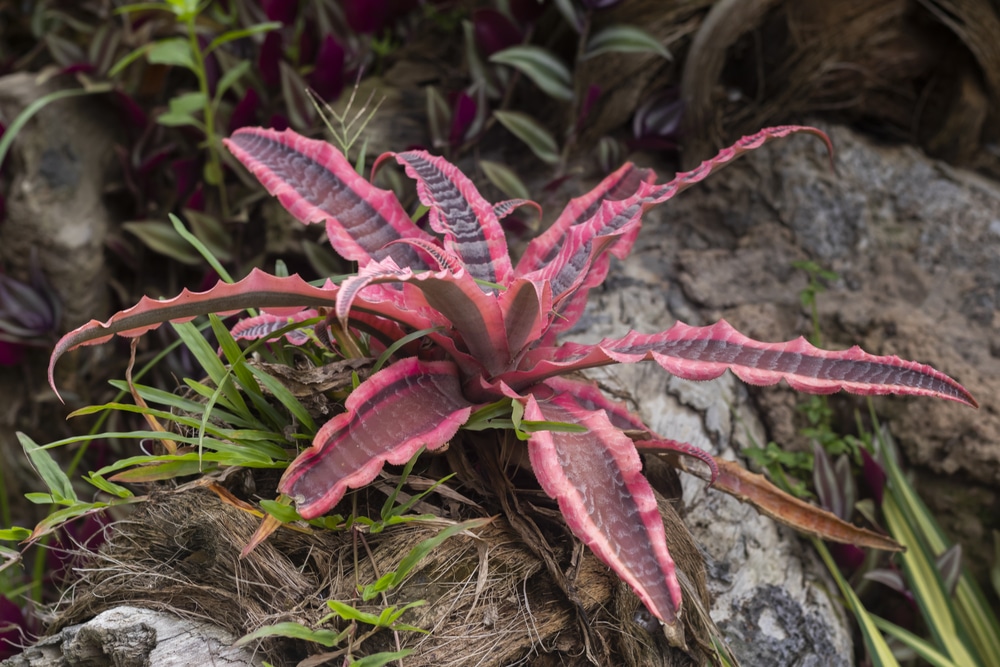
A terrestrial Bromeliad with an astonishing number of options for leaf size, shape, color, and patterns, there is sure to be one that fits perfectly in your terrarium. The foliage of Earth Stars is a flat rosette with stripes in pink, red, green, or white.
The plant, unfortunately, dies soon after flowering, but flowering can take several years. Utilizing this plant is a great way to add variety to your terrarium – every few years, you’ll need to switch it out for another Earth Star or possibly a whole different plant.
Bugleweed (Ajuga)
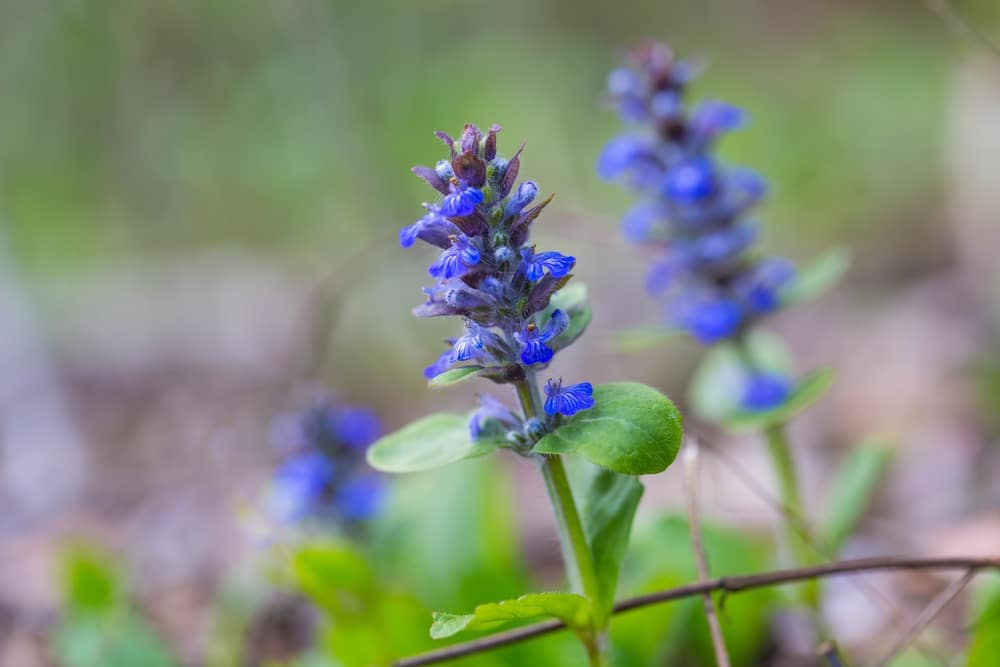
These small plants are often used for ground cover, but their small size also makes them perfect for terrariums. They grow quickly via multiple runners and create carpets of foliage very quickly.
Bugleweed grows between 6 and 8 inches tall and may need to be regularly pruned to prevent it from overshadowing other plants. On the plus side, if you’re looking for something to fill the terrarium quickly, Bugleweed has you covered. There are tons of colorful selections, including many with variegated bronze or metallic tinted leaves.
Check out the ‘Mahogany’ cultivar with almost black burgundy foliage or ‘Chocolate Chip’ with chocolate brown and purple varicolored leaves.
Baby’s Tears (Soleirolia)
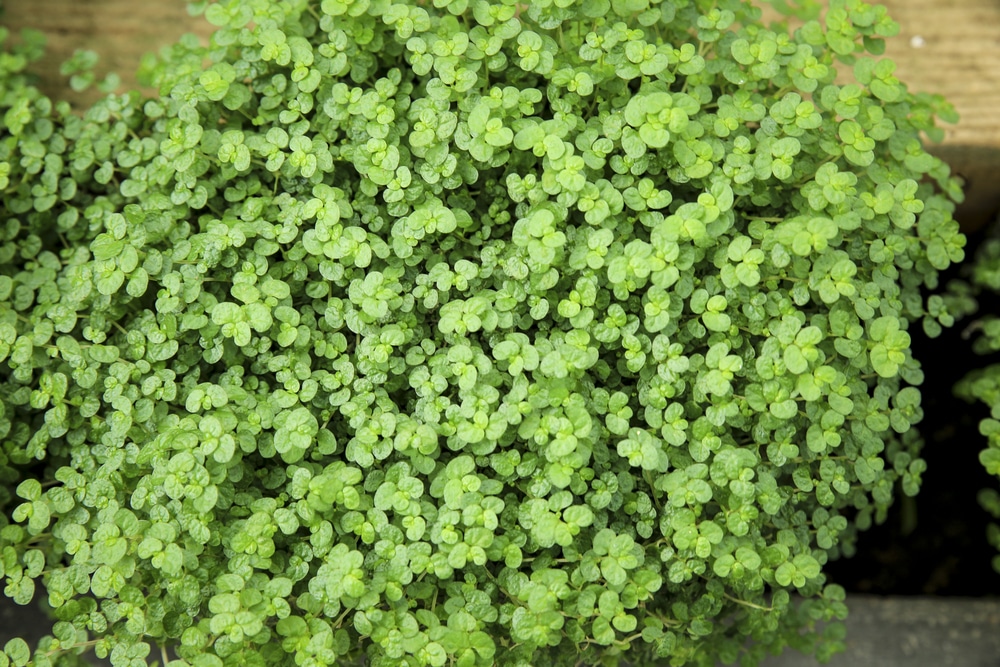
This fun plant with the sad title gets its name from the small, round leaves that cascade down thin, fragile stems. Baby’s Tears are also commonly called Mind-Your-Own-Business and Irish Moss. Someone had fun with names!
Baby’s Tears is a low and fast-growing evergreen plant that creeps along the soil. It does need to be watched and potentially trimmed back to keep it from crowding out other plants. This plant loves high humidity and warmth and comes in a nice variety of variegated versions to really light up a terrarium.
Mini Bloodleaf (Iresine herbstii)
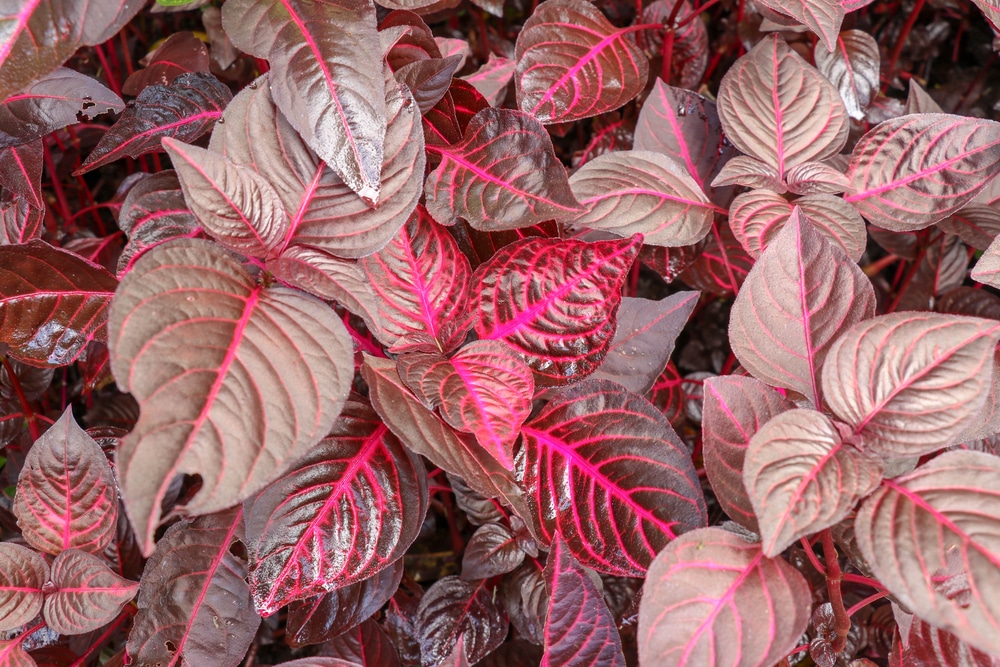
Brilliant red leaves with deep blood-red veins make this tropical plant really stand out, especially if all the other plants around it are green. Use Bloodleaf as a centerpiece in the terrarium so it can really pop with color.
Bloodleaf leaves grow 3-6 inches long and around 12-18 inches long. Some varieties feature red leaves with green, yellow, pink, or white veins. A collection of these in the terrarium would be truly spectacular. You can let the plant vine out or pinch back the stems to create a bushier appearance.
Flame Violets (Episcias)
This isn’t a true violet but is a relative of the tropical African violet. Flame Violets are petite plants that grow as ground cover. They are beloved for their incredible foliage, which is eye-catching and dramatic. The leaves are usually deep green and fuzzy, with vividly contrasting vein colors.
There are many cultivars to choose from, with bright pink, silver, copper, and light green veins. The hybrid varieties with pink leaves must be grown in terrariums as they suffer without lots of humidity. Check out “Cleopatra” and “Pink Dreams” for some really spectacular foliage.
Black Mondo Grass (Ophiopogon planiscapus)
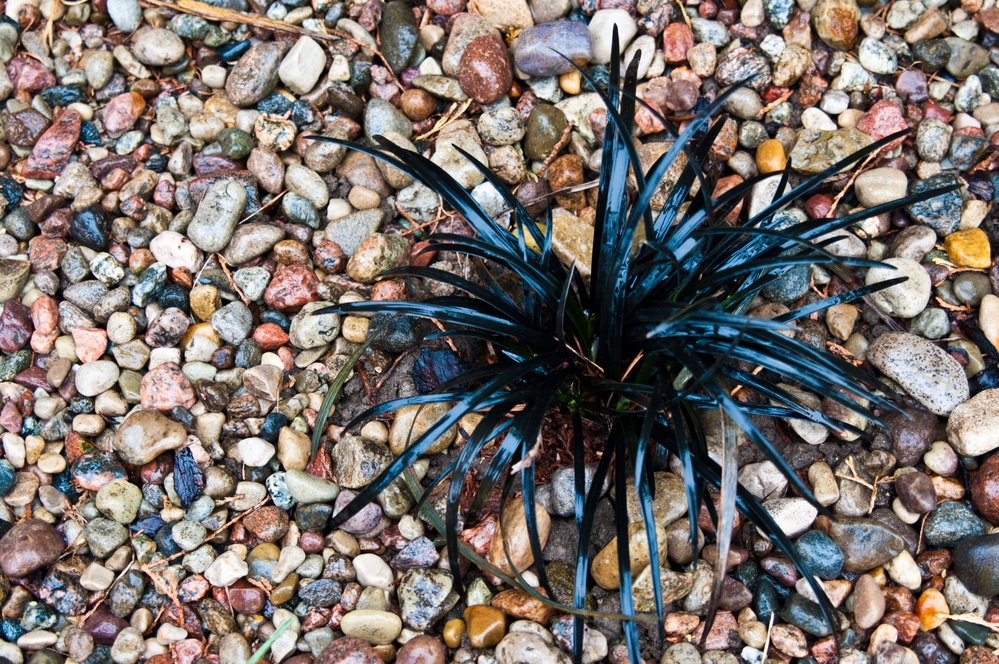
The dark-green to purple strappy and blade-like foliage of Black Mondo Grass adds character to the terrarium. Black Mondo Grass inspires quite a dramatic appearance with its dense, darkly colored leaves. It looks especially remarkable as a contrast plant, included among some bright green or pink foliage plants. Black Mondo Grass averages 6-8″ tall and may spread to 9-12″ wide.
Miniature Sweet Flag (Acorus gramineus ‘Minimus aureus’)
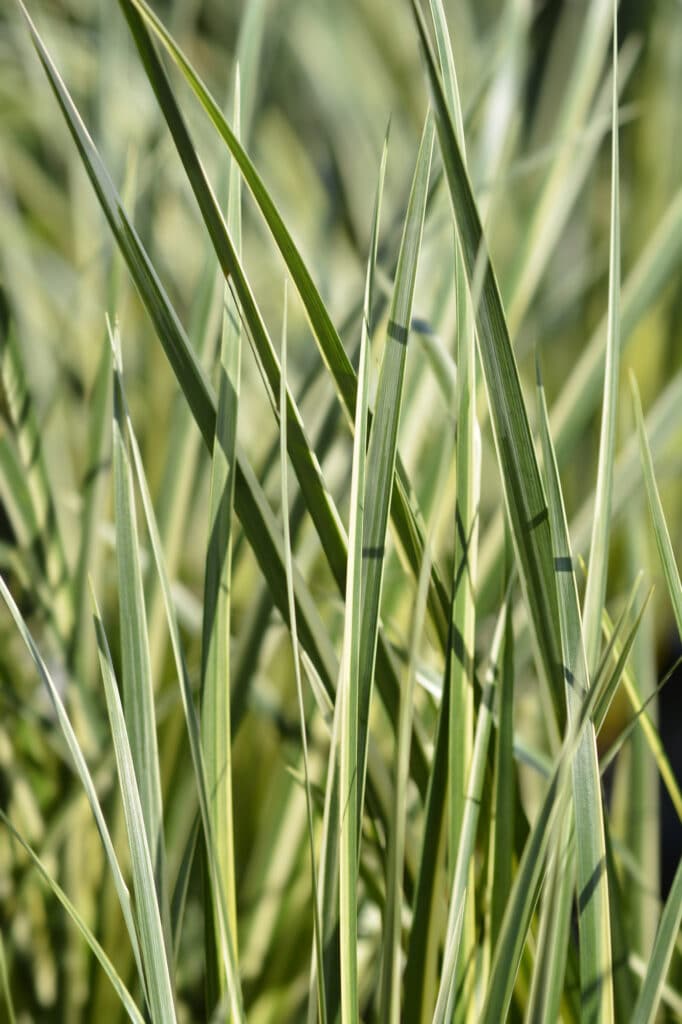
For a lush, grassy look, nothing beats Miniature Sweet Flag. This aquatic perennial produces clumps of bright yellow-green grass-like leaf blades that average 3-4” tall. The leaf blades fan outwards, creating a full, flourishing look. Over time, the clumps spread to form a mat of golden color.
Air Plants (Tillandsia)
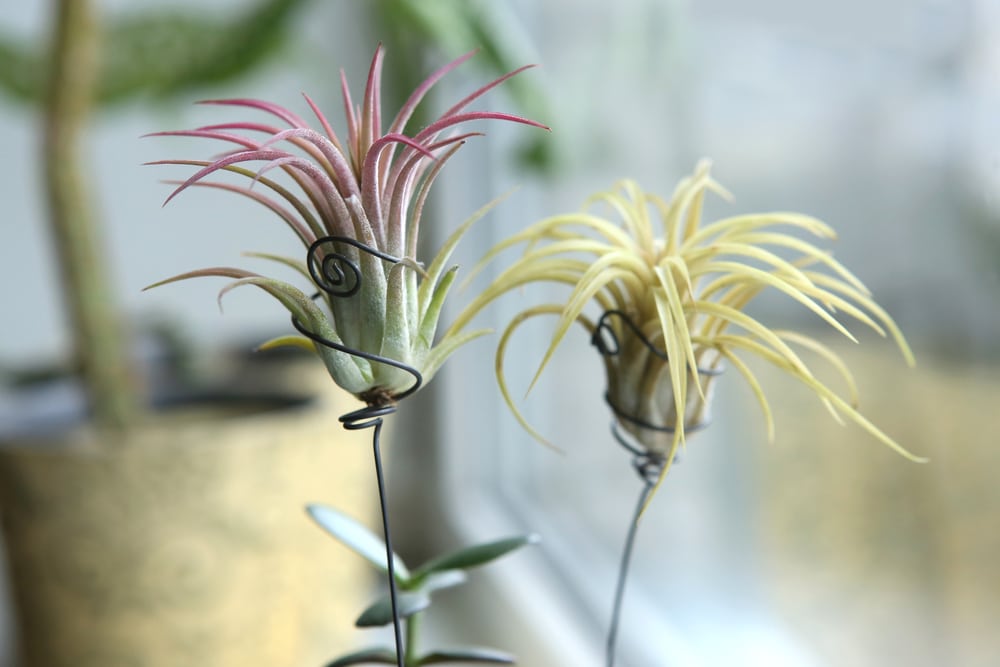
Air Plants are great because they don’t need soil. They don’t always mix well with other terrarium plants because their water needs are different. Air plants should never sit in water as that will cause them to rot. Also, they shouldn’t be in closed terrariums because they need regular airflow. However, a rock or moss terrarium with several air plants arranged around it is pretty beautiful.
Ferns
Ferns adore humidity and consistent heat, making them ideal plants for a closed terrarium. They also don’t usually need much light and are adaptable to many growing conditions. There are many fern types to choose from, ranging from miniature houseplant varieties to compact growth tropical species.
Maidenhair Ferns (Adiatum)
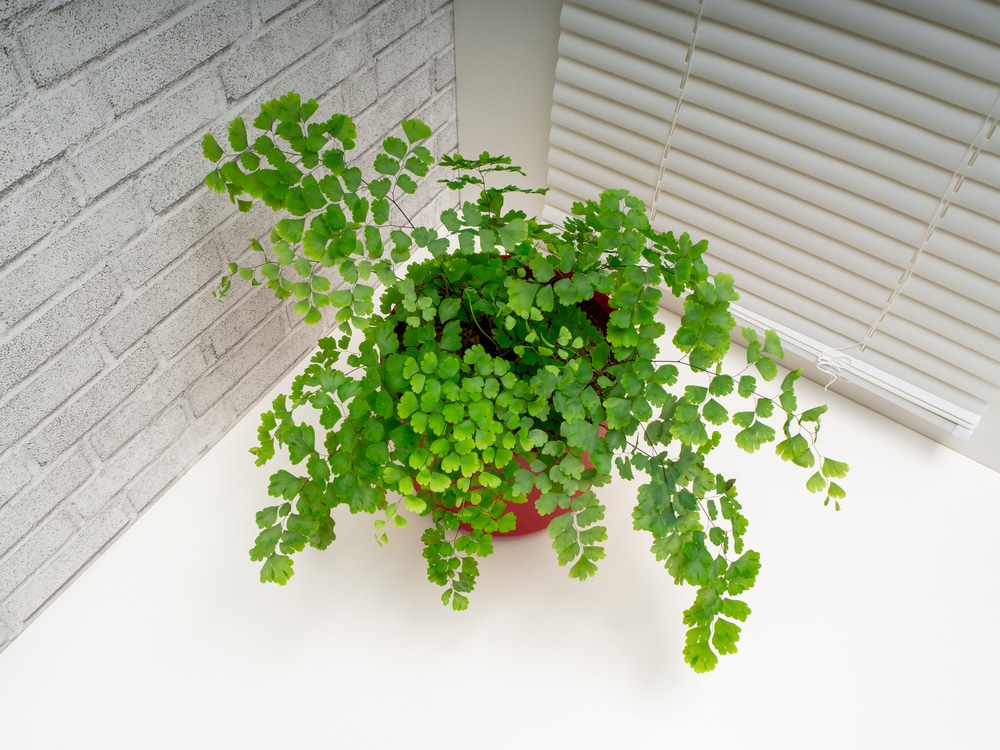
Maidenhair ferns provide a delicate touch to any terrarium. Their fine wiry stems and daintily textured foliage are unique in the fern world. The graceful arching fronds create a floating illusion as the stems blend into the background.
Maidenhair ferns tend to struggle in regular indoor environments because there isn’t enough humidity. However, this is what makes them ideal for a terrarium. If you’ve been wanting a Maidenhair fern but were worried about its finicky high-humidity needs, terrariums are the way to go with this one.
There are over 200 species of Maidenhair ferns, and most are relatively compact in size, another reason they’re great in terrariums. Some species stand out, though, as ideal terrarium specimens:
- ‘Mt. Haleakala’ Maidenhair Fern (Adiantum hispidulum) – This beautiful cultivar features eye-catching deep burgundy and green foliage. It grows up to 12” tall.
- Dwarf Maidenhair Fern (Adiantum microphyllum) – This species produces tiny, frilly green fronds and super thin black stems. It doesn’t get larger than 12” tall and grows in dense clumps.
Sword Ferns (Nephrolepis)
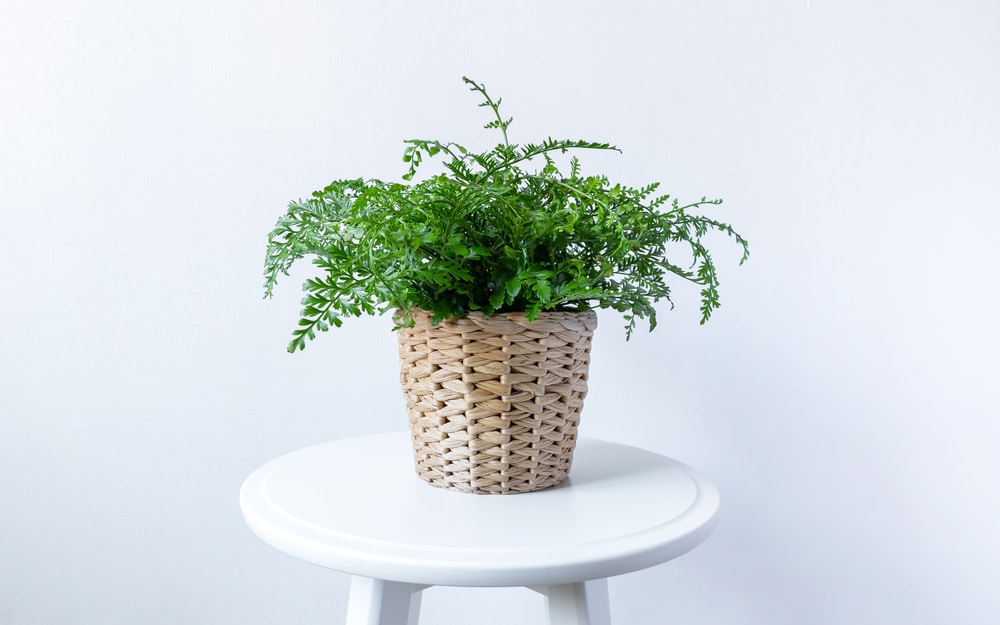
The pointy-tipped Sword-fern adds complexity and charisma to the terrarium. Sword ferns stand out with their sharp edges and brilliantly green foliage. Most people are familiar with the Boston Sword Fern (Nephrolepsis exaltata), but this common houseplant isn’t the best choice for a terrarium only because it gets quite large.
Thankfully, there are other stellar Sword ferns with a more compact growth that make them a better fit for a terrarium.
- Marisa (Nephrolepis exaltata ‘Marisa’) – A compact Sword fern with very dark green, lacy fronds that set it apart from other types. Averages 6-8” tall.
- Lemon Button Fern (Nephrolepis cordifolia ‘Duffi’) – The fronds feature rounded, button-like leaves with a light lemon scent. It grows up to 12″ tall and 12″ wide.
- ‘Mini Russells’ Miniature Boston Fern – A significantly smaller version of the classic Boston Fern that grows just 2” tall and 3” wide. It’s adorable!
Blue Rabbit’s Foot Fern (Phlebodium aureum)
The unusual bluish-green elongated and paw-shaped fronds of the Blue Rabbit’s Foot Fern look incredible in a terrarium. This isn’t always a small fern, so it’s best for larger terrarium setups. It is an epiphyte, so it needs something to attach to.
Blue Rabbit’s Foot Fern foliage is grayish-green or silvery blue, deeply lobed, and grows in wavy, irregular shapes. The plant produces fuzzy orangey amber-brown rhizomes that look like rabbits’ feet.
Brake Ferns (Pteris)
The forked, flat, arching fronds of Brake ferns are striking in their angular structure. They are even more sword-like than Sword ferns. Overall, they do not look anything like a traditional idea of a fern – the fronds resemble long lances and are often variegated.
Brake fern fronds tend to be brittle and struggle in indoor climates, but the humidity of a terrarium solves this issue easily. There are close to 300 species of Pteris ferns, and most don’t get more than 1-2 feet tall. This means there are lots to choose from for the terrarium.
Some favorites include:
- Silver Lace Fern (Pteris ensiformis) – Growing 12-16 inches tall, this species features deep green foliage with striking silver streaks down the center of each frond.
- Tricolor (Pteris quadriaurita) – Featuring bronze, green, and red fronds, this little Brake fern is a stunner. It grows up to 2′ tall, so it might not be suitable for more miniature terrariums.
Rabbit’s Foot Fern (Davallia fejeensis)
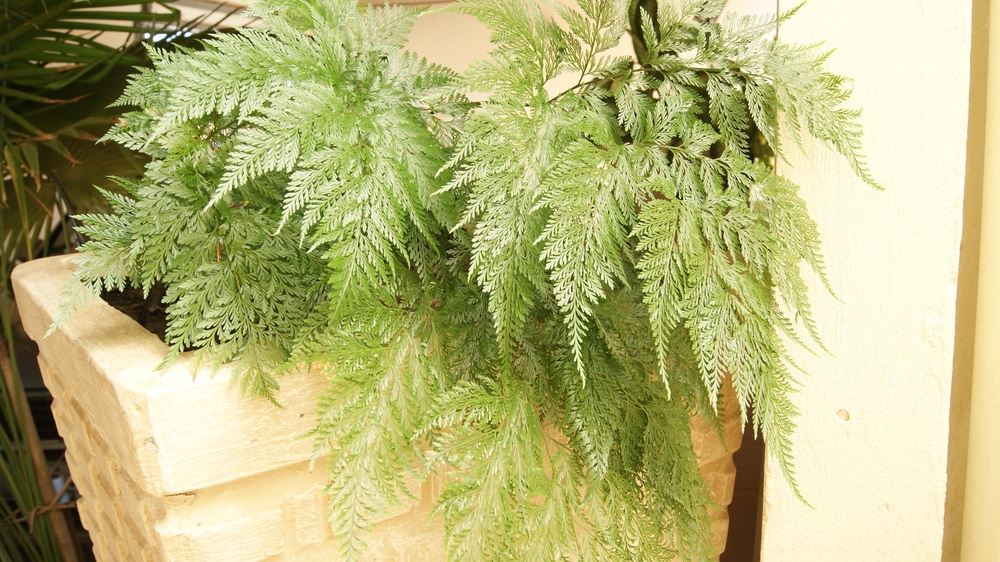
The fronds on this fern grow upright and are lace-like on wiry stems. The rhizomes are the main feature, though – they are incredibly furry, yellowish-brown, and creep around the edges of the plant roots. They look a lot like rabbits’ feet!
When planting this fern, make sure the rhizomes will be visible. The foliage grows up to a foot tall, and the “feet” really stretch out, so this plant works best in larger terrariums.
Spikemoss (Selaginella)
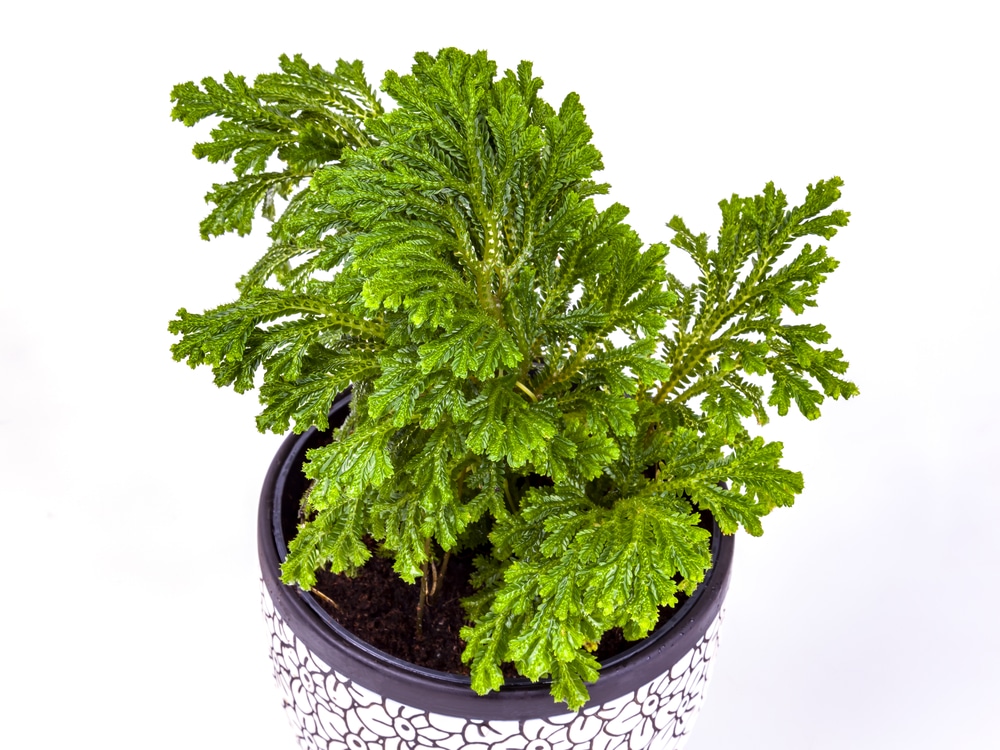
This little mat-forming plant with creeping stems adores high humidity. Spikemoss isn’t actually a fern, and it isn’t a moss either; it’s its own thing, and we fully support that. There are more than 700 species of Spikemoss, so there are lots to choose from for the terrarium.
Spikemoss foliage is small, lush, deep green, and very moss-like or fern-like in appearance – it depends a lot on the species. Some favorites are:
- Peacock Spikemoss – Prolific viner with iridescent foliage in greens, blues, and purples. Very attractive!
- Golden Clubmoss – Rich, lush, green fern-like foliage that always looks fresh and attractive.
Now that you know some of the best terrarium plants, it’s time for the most challenging part – narrowing the list down! Unfortunately, one terrarium cannot hold all these spectacular plants. Pick one or two as focus plants and build your terrarium around them. Once you’ve got one established, don’t be surprised if suddenly you’re creating 5-10 more. Terrariums are fun!


Hi Teri
One of my hobbies is stained glass an about to embark on making a terrarium. Reading your article was helpful. Many thanks
Hi Scott – Thanks for reading, I’m glad my article was helpful!